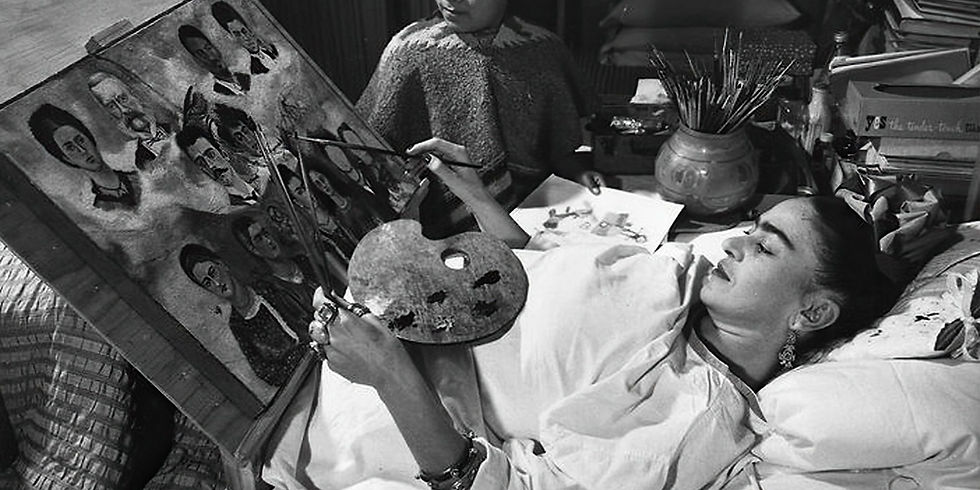The difference between selfie and self-portrait
- Loredana Denicola

- Apr 28, 2022
- 4 min read
Updated: Sep 14, 2023
Nowadays, we communicate only through images. We are bombarded with an excessive amount of information. Photography is changing.
I read that we all are photographers but is it true?
The perception we have of ourselves is entrusted to the photographic instrument. Photography is an indirect perceptual experience characterised by a certain degree of certainty - it has immortalised what has been.
But we don't see ourselves the way other people see us.
The perception we have of ourselves is different.
The mirror can only provide us with an inverted image of ourselves, very different from how everyone else looks at us. However, we inevitably get used to it. We obtain a correction of this image through photography, which offers us the visual perspective of others.
The ability to observe oneself through this perspective correction can lead to unexpected alienation effects (similar to what happens when we hear our recorded voice) interfering with the ability to fully recognise ourselves in the images that depict us.
When we come face to face with the camera, there is always a third element that triggers it at the right time. The third element is our desire for the other - the one who looks at us, the viewer we inevitably think of both when we shoot and when we choose the photograph. This third element is what allows us to see ourselves, to self-observe ourselves.
Photography is a medium that allows us to show what one would like or would have liked to be, overcoming the objectivity imposed by one's physical appearance.
The photographic image becomes a mirror in which to reflect one's gaze more deeply, to be able to observe from an external point of view what we aspire to be.
What is a self-portrait?

The self-portrait is a useful tool to dialogue with oneself and with one's own intentional gaze. This is true in the daily search for one's personal identity, as well as in the work carried out in the context of psychotherapy.
It is necessary to distinguish between the different forms of self-portrait.
On one hand, we have the selfie, which is not a self-portrait.

Its purpose is to faithfully represent us in the way we would like to appear.
These images and their sharing on social networks are aimed at obtaining immediate gratification through the approval of others. The production of these images is quick and automatic, as well as the satisfaction that derives from their exposure, rather than the process of realisation, which is easy.
Then, we have the self-portrait whose purpose is to generate an image of ourselves that represents not only what we are but also what we feel we are or would like to be. Here, there is a deeper communication, where the representation concerns not only the physical and body aspect but also through the expression of emotional, psychological, spiritual or artistic aspects. The self-portrait is generally made for oneself, not just for others - who are always present, as each image presupposes an observer, real or imaginary. The creative process is slower, it is studied.
The final gratification is released from the viewer.
While selfies are oriented towards sharing content, self-portraits allow the author to communicate not only the contents but also the processes and meanings behind them.
“As soon as I feel watched by the lens, everything changes: I put myself in the attitude of 'pose', I instantly make myself another body, I transform myself into an image in advance. This transformation is active: I feel that Photography creates or mortifies my body as it pleases ”(Barthes, 1980, p. 12).
Barthes said: “The photographic portrait is a closed force field. Four imaginaries meet there, confront each other, and are deformed there. In front of the camera, I am at the same time: who do I think I am, what I would like people to believe I am, what the photographer believes me to be and what he uses to show off his art "(Barthes, 1980, p. 15).
The self-portrait's exercise can coincide with the artistic performance, thanks to the subjective interaction of three components - author, subject, and spectator - what Barthes calls - operator, spectrum and spectator.
The same individual, in the different phases of the creative experience, in fact passes from the author's position to that of subject (object) and finally of the first user of the work.
Simply by telling something about ourselves - also through the use of self-portraits - we undergo a sort of detachment from ourselves, we observe ourselves from the outside and reinvent ourselves, transforming ourselves into other 'characters' who in some way resemble us but do not fully correspond to us (Demetrio, 1996).





Comments